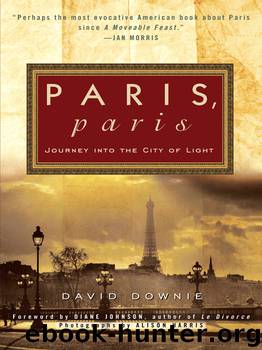Paris, Paris: Journey into the City of Light by David Downie

Author:David Downie [Downie, David]
Language: eng
Format: epub, mobi
ISBN: 978-0-307-88609-5
Publisher: Broadway Books
Published: 2011-04-04T16:00:00+00:00
The Perils of Pompidou
Cernimus exemplis oppida posse mori … (We learn from example that cities, too, can die …)
—RUTILIUS CLAUDIUS NAMATIANUS, De Reditu Suo, fifth century
ew cities can claim a tradition of urban vandalism nobler than that of Paris. Perhaps it’s genetic: archaeologists insist the Gauls burned their Seine-side settlements before going to battle, thus depriving rivals of the pleasure. Julius Caesar and his descendants endlessly reconfigured their fledgling city, as did generation upon generation of kings, French Revolutionaries, and emperors, who continued vandalizing Paris right into the modern age. When a ruler wanted something new he merrily tore down everything in his way.
But Parisians have not been immune to preservationist sentiments. For the past two hundred years or so those in command have usually prefaced their assaults by citing public safety, sanitation, or, that magic word, “modernity.” Many Paris connoisseurs think Emperor Napoléon III and his prefect Baron Haussmann were the archetypal modernizers: they flattened thousands of buildings for a variety of reasons, from bona fide health concerns to crowd control and rampant greed. Decried as a rape by sensitive souls such as poet Charles Baudelaire or Victor Hugo, “Haussmannization” was nonetheless carried out by visionary planners and skilled architects. Whatever they built was built to last.
What is less well publicized is that the vandal heritage, slowed occasionally by recession or war, has been the driving force behind each of the various French republics that followed the Second Empire. It peaked under the current “Fifth Republic,” which began in 1958. Predictably the orgy of state-sponsored speculation the new republic ushered in was dressed up as Haussmann-style modernization. This time it was not an emperor and a baron directing the show but an aging general and a little gray technocrat named Georges Pompidou.
Pompidou rose to power as De Gaulle’s right-hand man, moving in smooth succession from a 1958 advisory position to that of prime minister, before becoming president in 1969. A statesman, De Gaulle didn’t like cluttering his mind with minor concerns such as the economy, the environment, or urbanism. So he delegated. “Ask Pompidou,” he would say with a vague gesture.
Pompidou’s reign ended with his sudden death in 1974, meaning that he presided over France and the capital’s fortunes for sixteen years (Paris had no mayoral authority from 1871 to 1977). This was the height of les trente glorieuses—thirty glorious years of bull market.
When I hear someone say “Pompidou” I lift my eyes to Paris’s skyline and see the name writ large. Pompidou lives on in the opaque, sixty-story silhouette of the Tour Montparnasse and the nervy university complex of Jussieu that’s about half as tall. Look west and there’s Pompidou again, mastermind of the mock-Manhattan towers of La Défense. Of course, there are the multicolored pipes and Plexiglas tubes of the Pompidou Center at Beaubourg, a prime example of what was formerly (and without irony) called Brutalism, from the French word brut, as in raw or unfinished. That meant deconstructed structures with their guts exposed. Lower your eyes
Download
Paris, Paris: Journey into the City of Light by David Downie.mobi
This site does not store any files on its server. We only index and link to content provided by other sites. Please contact the content providers to delete copyright contents if any and email us, we'll remove relevant links or contents immediately.
Spell It Out by David Crystal(35846)
Underground: A Human History of the Worlds Beneath Our Feet by Will Hunt(11836)
A Year in the Merde by Stephen Clarke(5077)
Venice by Jan Morris(2428)
Claridge's: The Cookbook by Nail Martyn & Erickson Meredith(2257)
My Paris Kitchen: Recipes and Stories by Lebovitz David(2133)
A TIME OF GIFTS by Patrick Leigh Fermor(2101)
The Plantagenets by Dan Jones(1928)
Welcome to the Goddamn Ice Cube by Blair Braverman(1884)
Bang Poland: How To Make Love With Polish Girls In Poland by Roosh V(1856)
Top 10 Prague (EYEWITNESS TOP 10 TRAVEL GUIDES) by DK(1849)
The Finnish Way by Katja Pantzar(1805)
The Isle of Mull by Terry Marsh(1803)
From Russia with Lunch by David Smiedt(1793)
A TIME TO KEEP SILENCE by Patrick Leigh Fermor(1770)
Rick Steves London 2018 by Rick Steves & Gene Openshaw(1749)
A Taste of Paris by David Downie(1744)
Merde in Europe by Stephen Clarke(1671)
Insight Guides Experience Tokyo by Insight Guides(1658)
